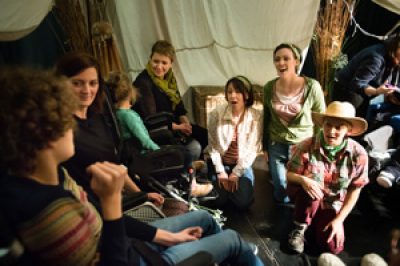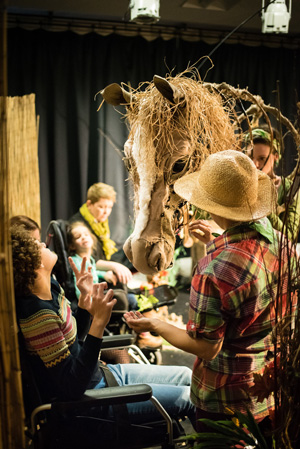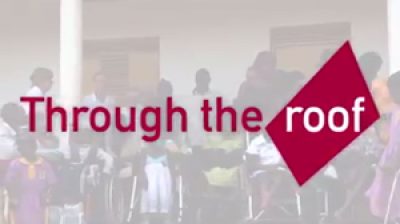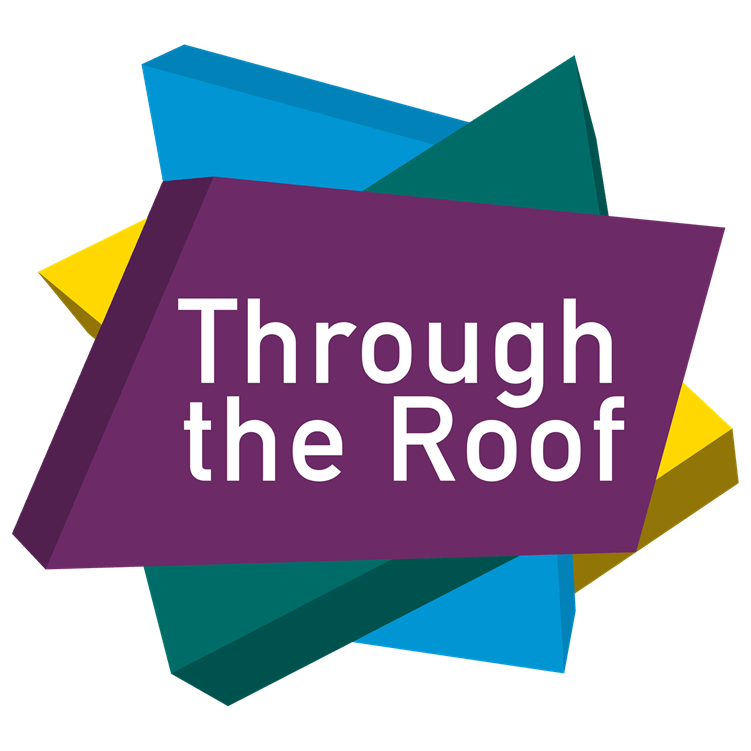You Belong Here (Ros' Blog)

This week’s guest blog post is written by Natasha Bunney. Natasha is a final year student at De Montfort University in Leicester, reading Education with French, and writing her dissertation on attitudes to disability in the classroom. She has worked and volunteered with disabled people for 10 years and has a sister with complex multiple disabilities.
-----
Last week I was invited to observe a theatre performance of the multi-sensory show Meadow Land by Bamboozle Theatre. Bamboozle is a company that puts on performances based on the principles of drama therapy and intensive interaction for children who are typically either autistic or labelled as having PMLD (profound and multiple learning disabilities). They work in schools as well as theatres to put on immersive performances for around 5 children at a time - the reason for this low number is so that they can get to know each child and involve them in the performance.
Before the show, performers meet and introduce themselves to every child, a relationship that continues to be built on throughout the performance. The show’s opening song welcomes all the children by name, and sets the context for both its narrative and ethos. Its lyrics explain that the children are welcome to participate however they would like, including doing nothing - a message that they are acceptable as they are, and their response to the show is valid no matter what. The show continues with each child being given the opportunity for one-to-one interaction with the various animal props and sensory experiences, but my favourite part of the show was its closing song.

The story goes that in the meadow it is beginning to rain, so all the children and performers have to go inside a tent. Once the tent has been put up around them, the performers sing a song called 'You Belong Here', in which they again name every child and tell them that they, both individually and collectively, belong there. What an empowering statement for a group of people who are often marginalised because of their differences.
I wonder if we as individuals and churches could learn something from Bamboozle. After all, God knows each person by name and cares about them deeply - why shouldn’t we? If the gospel, and church, are for everyone, what stops us from saying with our words and actions, “you belong here”? How can we value each person’s interaction with church and expression of their faith, regardless of whether it fits our expectations? And how can we see the possibility, rather than the disability, in our churches and communities?
(Pictures reproduced with kind permission from Bamboozle Theatre Company. Photographed by Martin Neeves Photography Ltd).
Bible Reading with Dyslexia (Ros' Blog)

This week’s blog post is taken from one submitted by Aurora Betony, a dyslexic adult who was identified with dyslexia in mid adulthood. Since then, she has been looking for ways to self-help individually and as part of a community of dyslexic people. She writes about her difficulties in reading a standard Bible because of dyslexia, and the solutions she has found to overcome the difficulties. It is a timely post, because Biblica Europe is currently developing an Accessible Bible for people with varied conditions such as dyslexia, learning disability and visual impairment.
Aurora describes how her condition affects her when she reads:
Taking in what I read
When I read the Bible, often a curious thing happens: I read the words but they don’t ‘go in’. For example, if I were to read a Bible passage in church, I might read it fluently, with expression. You might have the impression that I was following every word. But afterwards, if you asked me what it was about, I might not be able to tell you. In fact, I might not be able to tell you a single thing about it. The problem is, I struggle to read the words and think about their meaning at the same time. Why? Because I’m dyslexic. If you have dyslexia, your brain has to work harder to decode words than non-dyslexic brains do. The task of decoding words greatly occupies my brain, leaving little room for ‘taking in’, or processing, their meaning.
Remembering what I read
Another aspect of dyslexia is a difficulty with short-term memory. In the context of reading, this makes it all the more difficult to ‘take in’, or follow, something I read. I often struggle to assimilate the content of what I read because it’s too much for my short-term memory. That can apply at the level of a Bible passage but also over the course of an entire book. For example, by the time I reach the end of a chapter, I’ve often forgotten what happened at the beginning of it. Some chapters are trickier than others in this respect. Abstract concepts or facts and figures are very difficult for me to take in. But stories about people that include emotion are usually accessible.
Aurora has used a two-pronged approach – finding ways to overcome the difficulties, and finding ways to capitalise on her strengths (such as listening as well as reading). She explains a variety of techniques:
To solve the problem of unfamiliar words, I engage with the Bible through contemporary language using online resources and modern translations.
To help me ‘take in’ and remember Bible content, I use strategies and I recreate Bible content. Here are some examples.
-
Strategies
- Before reading a chapter in text I gain the gist of it via
- Audio
- Summaries
- I use more than one version for each chapter
- ‘Active reading’
- The following questions, written on a bookmark in my Bible, help me to focus my reading:
- What does this chapter say about God? About people? How should we respond to this chapter?
- 'Overlearning’
Exposing myself to the same story or passage from the Bible many times through different media, such as film, illustration, musical settings
-
Recreating Bible content
- I retell a chapter in my own words, as if I am telling it to someone else. I do this repeatedly until I can do it from memory
- I dramatise it, taking the role of one of the characters or acting out the story
- I create a visual presentation of it, for example I draw a timeline, spider diagram or annotated family tree.
To self-help with everything I find difficult, I use an approach that is:
- Multi-sensory: print, audio, visual, drama and music
- Interactive:e.g. active reading and recreating Bible content
- Incremental: and repetitious gradually building my learning of each chapter using lots of small steps e.g. exposing myself to the material repeatedly and in different formats
- Flexible:I adapt how many and which strategies I use
- Appropriate for me: I adjust my expectations according to what is realistic and achievable for me e.g. with chapters I find particularly difficult, I limit my objectives by focusing on the one thing that stands out most for me
I’m certain Aurora’s tips will be of help to other dyslexic people – and anyone else – who would like to be able to explore the Bible more. Biblica has produced a video about its forthcoming Accessible Bible, which you can watch by following this link.
Bible reading is not simply an end in itself, but as Pete Winmill reminds us in the video, we know that Jesus is at the heart of the Bible, and we want to know more about Him. As we read it, it has a profound effect, bringing not merely information but transformation. As Charles Spurgeon once said, “The Bible is always a new book. There is not a stale page in the Word of God. It is just as fresh as though the ink were not yet dry.”
Aurora Betony has written a comprehensive article on what helps her engage with the Bible. It can be found by following this link.
An Introduction to Through the Roof

Find out all about Through the Roof in our new video, 'An Introduction to Through the Roof'. This video, which talks about all our different programmes and features short interviews with supporters and volunteers, has been produced through the hard work of 3 Strands Media. We hope you enjoy it - please share it around anyone you think might benefit from knowing more about TTR!
See the Possibility : Our New Video

Through the Roof would like to encourage you all to 'See the Possibility, Not the Disability', with our new video (produced with 3 Strands Media). Have a look below and let us know what you think...
Through the Roof: See the Possibility from 3 Strands Media on Vimeo.

